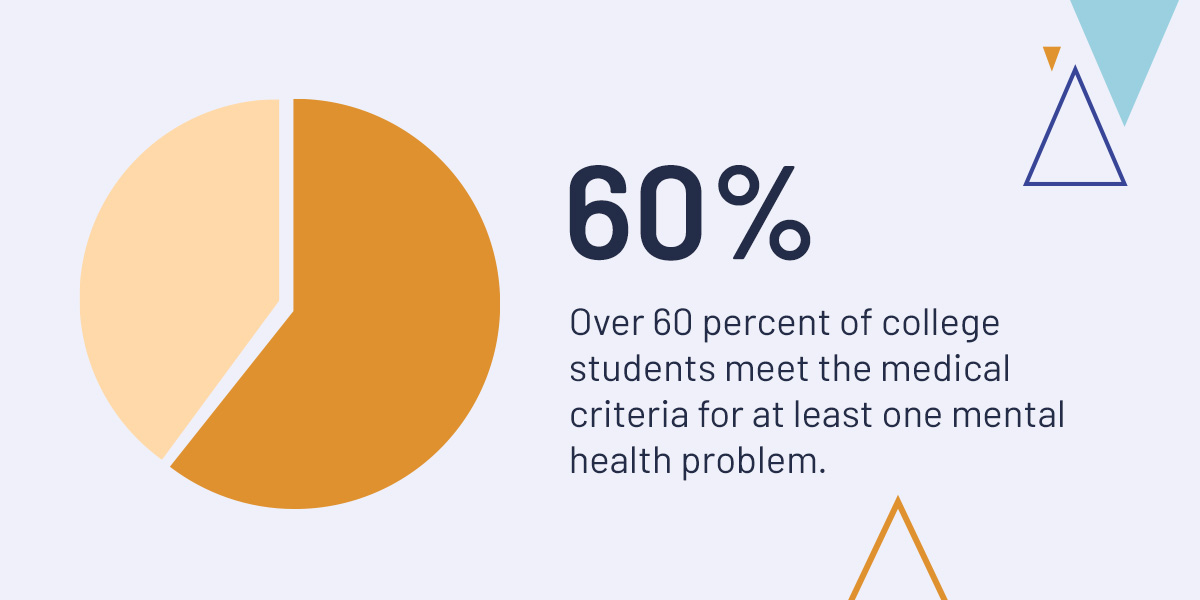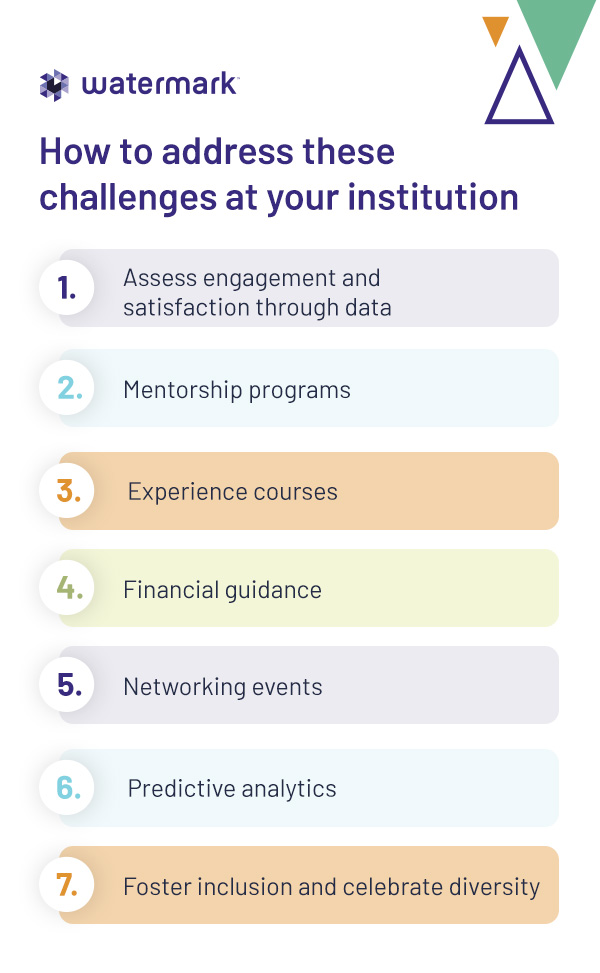




The transition to higher education can be overwhelming for first-year students. Adjusting to a new schedule, schoolwork, and roommates can be challenging. As an administrator or institutional decision-maker, you can implement several initiatives to make the transition easier for freshmen. Mentorship programs, experience courses, engagement software, and other efforts can ensure your students are excited and engaged in their education.
The following are 15 common challenges first-year students face at higher education institutions and how to ease them through this huge transitional period.
Adjusting to college life can be overwhelming for first-year students. They have been hearing about higher education for years. Now that they are finally entering this new chapter of life, they face several changes all at once — a new routine, a new home, new classes, and new friends. While these changes can be exciting, it is normal for students to experience sadness or anxiety as they adjust or reconcile their expectations about college with reality.
These feelings typically dissipate within the first few months of school as they get more comfortable with the newness. However, implementing initiatives to make students feel excited about these changes and comfortable opening up about how they feel is important.
College living can leave students feeling homesick, whether they live a half hour away from home or across the country. Being away from friends and family, situated in a new space, and surrounded by unfamiliar faces, places, and routines can create a longing for the sense of security and belonging that home provides.
While students should keep in touch with family and old friends, they should also join the campus community and make new companions. As time passes and the campus starts feeling more comfortable, homesickness typically lessens.
Making friends in a new environment can be challenging, especially for students fresh out of high school who are entering are establishing themselves among the unfamiliar.
While this new independence presents exciting opportunities for college students, making friends and independent decisions during such a quick transition can be overwhelming. Studies find that loneliness is higher among first-year students as they are adjusting to a new place and balancing school work with their social lives. Loneliness can lead to feelings of depression, low sleep quality, and reduced general health.
While many students may not be at the legal age to drink alcohol when entering their first year of higher education, drinking is often still a reality. Freshmen students are making independent decisions — sometimes for the first time in their lives — and not all of these choices positively impact their studies.
Some students might not be interested in partying or alcohol, yet feel pressured to participate. For this reason, administrators should implement support services for college students dealing with challenges regarding drinking. Comprehensive policies can include prohibiting drinking by minors, requiring identification checks at events where alcohol is served, and ensuring that alcohol-free beverages are available at all functions.
Cohabitating is also a major source of first-year college student problems. Many people have never had to share a small space with another person, let alone a stranger. Living with others can be challenging, requiring healthy communication to resolve conflicts and agree to certain living rules. Different sleep and study schedules, friend groups, and other issues can arise. Maintaining clear and open communication from day one can assist in this substantial transitional period.
Eating healthy and staying active can be challenging for people entering their first year of college. On top of busy schedules and robust coursework, students may find maintaining a consistent routine and making healthy decisions for themselves challenging. Many individuals are adjusting to not having parents and guardians provide meals for them. Others are learning how to stay healthy without high school sports to stay active.
A healthy body contributes to a healthy mind, so establishing positive eating and physical fitness habits is key. Administrators can implement helpful initiatives such as workshops on healthy eating, nutritionist access, or club sports and group fitness classes.
Like exercise and eating healthy, quality sleep is crucial for learner well-being and performance. Without enough sleep, grades can slip, and first-year students can have trouble focusing on their education. Inadequate sleep can also mean less energy to enjoy time with friends.
Encouraging individuals to get at least eight to nine hours of sleep each night and to avoid staying up late to study or socialize is a good idea. Higher education institutions can also offer healthy caffeine alternatives to promote well-being and reduce the negative impacts of coffee or energy drinks on a good night’s rest.
Money can be a top stressor for first-year students paying for their education. Fortunately, individuals can often find restaurants, museums and movie theaters around campus that offer student discounts.
Scholarships are also a huge asset, so students should be encouraged to pursue these opportunities whenever possible. As an administrator, ensure that you have plenty of financial advisors available through your campus career center to help with tuition and financial issues. Your higher education institution’s students can have more peace of mind when they have help budgeting and making economic decisions in their first year.
Schoolwork and academic stress are immense challenges for students transitioning to college. Since academic performance is among the most important aspects of higher education, the pressure to excel can be heavy on learners, and busy schedules can feel overwhelming.
Worrying about grades, finances, loans, and the ability to find a job after college is easy for first-year students. An intense workload, rigorous coursework, and high expectations set by themselves or others can lead to excessive stress.
In this new chapter, first-year college students must learn how to balance their personal lives, academic responsibilities, and social engagements independently.
While at home, parents, teachers, and coaches often provide students with structure and finite timelines. In higher education, most individuals do not have someone who is monitoring their activity and ensuring they are managing their time well. Adjustments can be challenging to handle independently, requiring prioritization and boundaries to keep a healthy balance and prevent stress.
Students must learn how to delegate time for studying, attending club activities, and going to work. They must also set aside time for relaxation and self-care to ensure they are adequately recharging their batteries to avoid burnout.
Mental health challenges are very common first-year student problems. The pressure of transitioning to a new environment, in combination with the demands of college life, can contribute to higher anxiety and depression among college students.
Over 60 percent of college students meet the medical criteria for at least one mental health problem. Unfortunately, many of these students are reluctant to reach out for help.
Higher education institutions can offer accessible counseling services and mental health resources to help students cope with these challenges and thrive on campus. Promoting healthy lifestyle habits like exercise, nutritious diets, and adequate sleep can also impact the well-being of your students.
Building and maintaining relationships can be challenging, especially when also navigating the demands of college life. Students face a new beginning where they can meet people and explore new experiences. It is vital to promote safe practices, have campus counselors available, and offer plenty of opportunities for students to meet and connect with others.
For example, students can join clubs, sororities, fraternities, or other organizations to make friends with people who enjoy shared interests. Participating in campus events and experiences can help students balance their social and academic lives.
Effective studying and balancing coursework are critical skills in college. Students should set aside plenty of time to review their coursework in their first year. By establishing realistic goals, students can achieve good grades, avoid stress, and feel more confident. Promoting different study strategies is also a good idea to help students determine a routine that works best. Students might even form study groups to maintain focus on academics while also making new friends.
Colleges can also implement study break activities, like animal therapy, where students can take a break and relax to avoid stress while studying.
A recent survey found that a third of first-year college students reported feeling targeted or excluded based on their identity. The exact data shows over half of nonbinary students felt this way, as did 34 percent of Black students and a third of women.
Today’s students tend to choose colleges based on whether they feel supportive factors are in place to help them feel safe. For this reason, leaders in higher education should note how student satisfaction varies by ethnicity, race, and socioeconomic background. Awareness of the disparities can go a long way in creating a more inclusive college experience for all.
The future and what it may bring is a common source of stress among first-year students. Academic decisions can shape a student’s educational path and influence their prospective career opportunities.
From selecting a major to evaluating career paths, these decisions can feel overwhelming and daunting. Studies find that a lack of job opportunities and a fear of failure has led to increased levels of anxiety about the future among students.
As an administrator or institutional decision-maker, you can implement several strategies to help first-year students overcome common challenges and feel engaged in their academic journey. These actions can prove to students that you care for their well-being, academic success and future career paths after graduation.
Identify tangible ways to help students through their first year by measuring student engagement. You can gather quantitative data about student attitudes through surveys, correlational research, and cross-sectional studies. It’s also critical to look at qualitative data to get a closer look at the individual experience, whether through focus groups, interviews, or observation.
Using multiple strategies and software to centralize this process can help you increase student engagement and satisfaction for first-years and beyond. For example, your data might help you determine whether to adjust teaching practices or craft new courses that reflect each student’s interests and career goals.
Set your students up to succeed on day one with mentorship programs. Mentors could be current learners, faculty members, administrators or alumni who can provide guidance and support. Individuals can ask questions, get advice and learn what to expect from their first year to help them transition smoothly.
Like mentorship programs, experience courses provide opportunities for new students to navigate everyday challenges, manage time, set realistic goals and ultimately, set themselves up for success in their academic journey. These courses are meant for first-year students, encouraging a favorable transition from high school to college and establishing a new support system.
Experience course assignments usually include learning how to use the college’s technology, how to develop personal goals and learning to develop relationships and opportunities outside of the classroom.
A lack of institutional or staff support can lead to students dropping out of school. Be sure you have available academic, equity and financial help to support students in their first year of school and beyond.
Academic advisors can help students overcome economic challenges and persevere, whether assisting in budgeting, finding financial assistance, applying for scholarships, or seeking careers and part-time jobs.
Students can actively engage in networking events and career exploration to alleviate their worries about the future. Be sure to offer plenty of career fairs, workshops, and networking events so students can gain insights into different industries and guide potential career paths. Learners can also seek guidance from academic advisors to help make informed choices that reflect their interests, aspirations, and long-term goals.
Predictive analytics software can identify issues before they occur, allowing student success coaches to flag at-risk students and enact changes. The software leverages historical data to determine each student’s needs and the specific challenges they could encounter on their path to success.
Students venture to your campus from all walks of life, and you must do what you can to satisfy each person’s needs. Discrimination, bullying, and racial harassment can significantly impact the academic experience, making it vital that your campus has the resources and tools to guide these students to success. Foster a safe, supportive and welcoming institution that will benefit every individual.
Additionally, offer and promote extra support services like counseling centers, disability resources, multicultural student affairs offices and other resources to advocate for students through their first year.
Entering a new chapter of life, like college, can bring excitement, opportunities, and growing pains. Decision-makers can meet the challenges that first-year students face with mentorship programs, counseling services, networking events, and financial guidance.
Watermark Student Success & Engagement allows higher education institutions to drive positive change and drive students to success. We empower colleges and universities to support meaningful data collection, measurement and review. With the right tools, you can improve institutional effectiveness and learning outcomes while helping students overcome challenges in their first year.
Request a demo of our solutions today to see how Watermark can help your institution and learners thrive.






















































































































































































































































































































































































Submit this form to schedule a meeting with one of our reps to learn more about our solutions. If you need customer support instead, click here.



